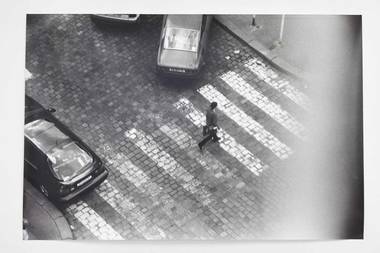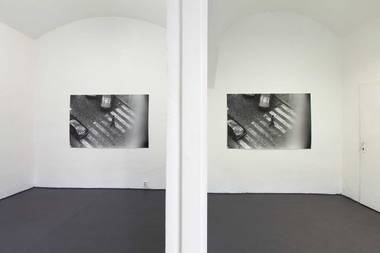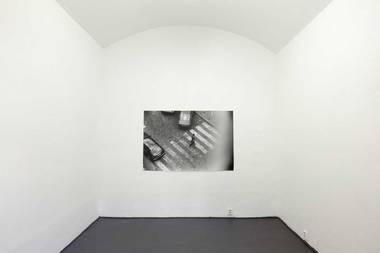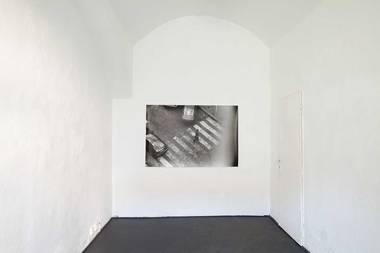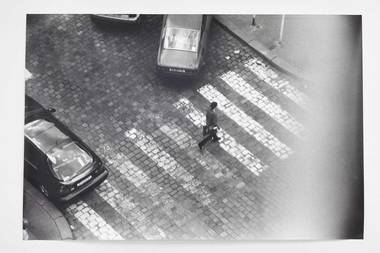Markéta Othová: Don´t Go Anywhere
29. 4. – 14. 5. 2015
opening: úterý 28. 4. 2015
curator: Gabriela Kotiková
Gabriela Kotiková: Markéta, I have a few questions I’d like to ask you. I’ve noticed that you have recently started using colour photographs. How did it happen that you decided to try this style, which is new for you? Did you not have reservations towards it before? What convinced you?
Markéta Othová: Black and white photographs look much more ordinary than coloured ones; it was the simplest way of taking pictures, it never occurred to me to take colour photos, a proper photograph was supposed to be black and white. Now, on the contrary, with the powerful influx of digital cameras colour pictures look the most ordinary. I can see that my first colour photograph is from 2008 – it’s a photo of a towel on a table; I thought of it as a big joke that it was in colour. I didn’t exactly have reservations, I just thought it was strange and maybe that’s why I tried using it. It was not till later on that I noticed I no longer take new black and white photos.
GK: Do you have any problems with the fact that you can’t influence your photographs now like in the case of black and white photos in a dark room? And, on the contrary, what advantages can colour photos have?
MO: The fact that I actually captured something on my black and white negatives was always partly chance and partly some unpredictable coincidence; I’m not a photographer in the right sense of the word, so I never got into some refinements in the darkroom, I used to just make A4 previews myself, and photos for exhibitions I always did with some professional, but working in the darkroom is very nice, that’s true. The biggest problem I see with digital photography is the fact that the photo is too good, you can see the result right away and it can also be amended right away, it’s more difficult to choose and even more difficult to take photos – we all take pictures of everything and the question arises: why? The work is completely different in all aspects – it’s fast, happier, less serious, less mystic, somewhat boring and also a little bit useless.
GK: For your exhibition at the Jeleni Gallery you were considering exhibiting several colour photographs. But later you decided to do something else.
MO: Yes, here for the Jeleni Gallery I prepared several colour photographs of various insignificant household things – some cloths lying around, and then this larger photograph of a girl stuck to a wall in order to get the right shot. It was all supposed to be about photographing things, but in the end it seemed to me that it was too strange and artsy, so I decided for this simpler alternative.
GK: For an inexperienced viewer, these two black and white photos with a title can resemble your exhibition in the lobby of the Trade Fair Palace in 1998. It is so similar, however, that it will most likely not be “a repetition of itself”.
MO: This is a direct reference to the thing from the Trade Fair Palace that you are talking about; it’s rather a reference for an experienced viewer; it’s actually the same thing only the girl in the photo is different, it was taken practically at the same moment. That’s what I was a little bit afraid of, citing myself, but it’s hanging here because it’s you who is walking on that street and it’s all supposed to be a joke; and the place here seems to me to be the only great one possible. It’s a poetic adventure game.
GK: How did the original exhibition “Her Life” originate back then? I remember that it was surprising to me that the photographs are linked with the Trade Fair Palace by being views out of its windows, to be exact one single photograph of a view from the window kept repeating there. I think it was different working style than you had been using until then; other times I think that your photographs did not relate with the gallery space in any way....
MO: Actually back then it was an assignment, if I remember correctly Tomáš Pospiszyl, as the curator in the Fair Trade Palace, invited me to take pictures there and that the exhibition will consist of those photos. It was a very difficult situation for me and I got out of it after four desperate days of taking pictures inside by pointing the lens outside, and you were walking there... back then I chose the other girl, because the photograph was more abstract and I think that no one knew that girl or woman. I exhibited the same shot six times, the area of the small lobby was so huge that I had the feeling that it was not possible to work with it in another way. I liked the idea that by the time you walk from one photo to the next, you forget what exactly was on the first one and maybe you don’t realize it until the forth one, after you’ve gone back a couple of times, that the picture does not change. It was an extremely amplified moment. Thanks to the large space the whole thing was not obvious at first sight but it was discovered along the way.
GK: Back then it was quite courageous and surprising... Did you register also some negative responses? I think at that time it was hardly comprehensible even for some curators. It was not until later that this exhibition became a breakthrough.
MO: The first panic reactions started when during the unloading of the framed photos from the car and someone said that there’s been a mistake that all the photos are the same. Then there were some telephone complaints from photographers that the photos are out of focus; even some friends of my parents were saying something like “that’s just not acceptable”. Now that I think about it, I feel like it couldn’t even be true. It’s kind of funny. I had a good feeling of victory back then.
GK: The current exhibition in the Jeleni Gallery takes another moment from history that took place around that exhibition in the Trade Fair Palace. It’s like you revived a moment that happened back then but was not at all important. All of a sudden it takes on a new meaning; it’s a document that gets further content from the name of the exhibition. At the same time it’s still primarily an abstract visual impression, which is very effective. Do you think that a viewer who is not familiar with all the circumstances regarding the origin of this photograph can comprehend this work in any way? Although, now that I think of it, every photograph has a hidden story that the viewer cannot know and every photograph has a story concealed from the time of its origin...
MO: It’s true that someone who has not seen the photos from the Trade Fair Palace and will not even recognize you because you are actually not that recognizable... I can’t imagine what he/she will think. At that moment what should work is that there is someone twice on the photo who is going somewhere and it’s called “Don’t go anywhere”, plus there’s the abstract visual impression... hopefully that will be enough.
Jeleni Gallery exhibition program is possible through kind support of Ministry of Culture of the Czech Republic and Prague City Council
Media support: Artycok.tv, ArtMap and jlbjlt.net
